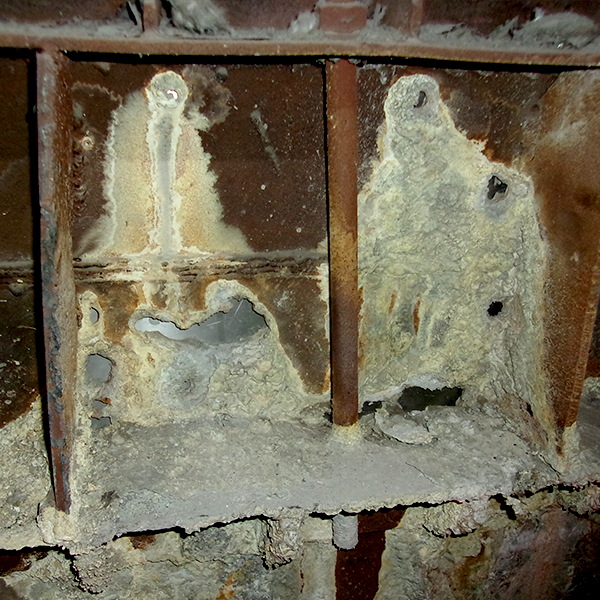IA mobilized to perform a detailed condition assessment that includes a visual photographic inspection, a drone inspection, and Ultrasonic Testing (UT) readings. In addition, a section from the flue can inlet duct was cut out and submitted to Applied Technical Services (ATS) for a metallurgical failure analysis to provide further information about the potential cause of rapid liner failure.
The interior inspection of the liner was carried out at approx. EL. 131’ – 623’ from grade, and the condition was concluded to be poor. IA crew noted severe corrosion in the titanium cladding in many locations, at some of which holes were present, revealing the oxidized underlying steel and compromising the structural integrity of the liner. The most compromised areas were at the circumferential splices between adjacent cans and at the liner support locations (vertical and horizontal). Such severe localized corrosion at support points is a major concern as it could lead to catastrophic failure of the structure as a whole. Additionally, IA observed some improper welds of the titanium plates that had been installed over corroded areas. There were gaps present in the welding, which could be allowing flue gases and condensates to penetrate behind the titanium sheets and accelerate corrosion. This could also become a potential safety hazard, since the flowing gas could cause the unwelded edge to flutter and result in titanium sheeting pieces getting ejected from the top of the chimney.
The exterior inspection of the liner was carried out from the annulus at approx. EL. 98’ – 623’ from grade. IA crew observed damaged and missing insulation in multiple locations of the flue can splices and reinforcement. These locations provide increased surface areas for the dissipation of heat, so leaving these surfaces uninsulated could allow acidic condensation to develop and increase the chances of forming corrosion. Widespread holes with leaked flue gases and condensates were noted on the liner exterior, which have further corroded the structure and in some cases dripped onto the support framing, causing oxidation. IA detected overstressed buckling stiffeners, thinning plate, compromised lateral support bumpers, and signs of wildlife entry. Moreover, the welding of the titanium plates on the interior has been done without patching and reinforcing the liner body itself. Therefore, the titanium plating was visible through the holes at many locations, which is a serious concern for the structural integrity of the liner.
UT readings were mostly consistent with the design thickness of the liner. Nonetheless, low readings were still observed in multiple areas, although these were in all probability the thickness of the titanium cladding and not the steel liner. The readings were consistent with the fact that the observed corrosion is highly localized due to chemical attack, and general surface erosion or corrosion of the liner did not appear to have taken place.























